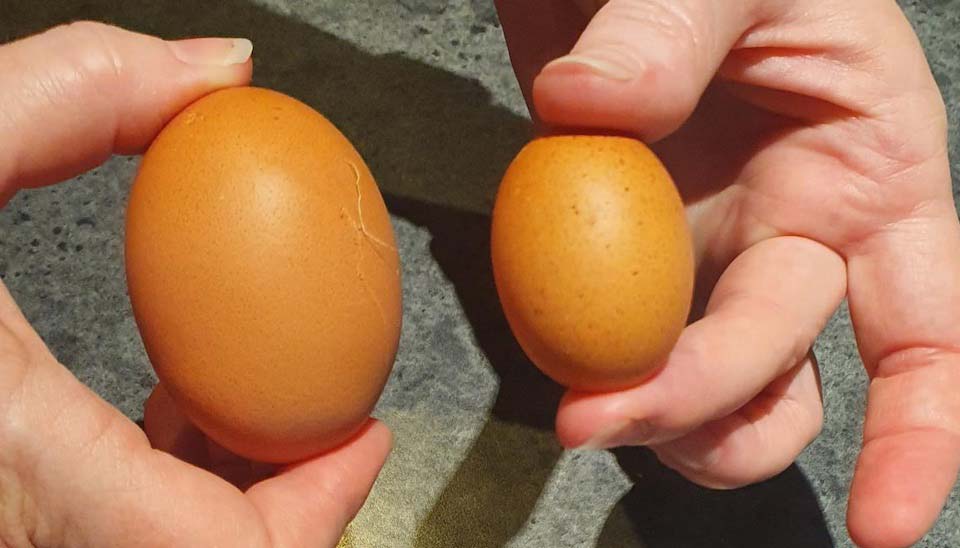It can be concerning when you reach into your chicken coop to collect eggs and find tiny, miniature eggs instead of the usual large ones. These small eggs are often called fairy eggs or wind eggs, and there are a few potential reasons why your hen may be laying them.
What are Fairy Eggs?
Fairy eggs, also known as wind eggs, witch eggs, or, are very small, yolkless eggs that occasionally get laid by hens. They are typically about the size of a quail egg and occur when a small piece of reproductive tissue breaks off and triggers the hen’s egg-producing glands. This causes a bit of egg white and shell to form around the tissue, resulting in a tiny egg.
When you crack open a fairy egg you’ll typically find just egg white and sometimes a smear of yolk or small piece of tissue from the reproductive tract. Fairy eggs are completely edible, though some people find the tissue unappetizing. They can be fed back to chickens or dogs too.
Why Do Hens Lay Fairy Eggs?
There are a few potential reasons why a hen might lay fairy or wind eggs:
- Young pullets – It’s common for young hens who just started laying to lay some fairy eggs as their reproductive system matures. This is normal.
- Older hens – Older hens with worn out reproductive systems may lay more fairy eggs as things don’t function perfectly anymore
- Stress – Stressful events like overcrowding, predator attacks, too many roosters, or temperature extremes can cause fairy eggs.
- Nutrient deficiencies – Lack of calcium or protein in the diet can lead to small eggs.
- Illness or pests – Sickness, mites, and other issues may trigger some fairy eggs.
- No reason – Sometimes they just happen sporadically for unknown reasons!
Is it a Problem?
An occasional fairy egg here and there is usually not a cause for concern. However, if your hen starts laying many tiny eggs frequently, it could signify an underlying issue. Things to look into include:
- Excess stress
- Nutrition deficiencies
- Illness
- Pests like mites
- Other causes of reproductive issues
It’s a good idea to thoroughly inspect your flock and coop if the problem persists.
Encouraging Healthy Egg Laying
To promote normal, healthy egg laying, focus on providing:
- Adequate calcium – Supplement feed with oyster shell or crushed eggshells. Lack of calcium causes thin shells and tiny eggs.
- Sufficient protein – Shoot for at least 16% protein in feed or offer high protein treats. Protein is key for egg production.
- Minimal stress – Reduce crowding, predators, extreme temperatures, and other stressors as much as possible. Stress can wreak havoc on laying.
- Overall flock health – Prevent and treat illness, parasites, injuries, and other issues promptly. Healthy hens lay better quality eggs.
- Good layer feed – Feed a complete layer ration formulated for hens actively laying eggs. This provides balanced nutrition.
With proper care and nutrition, most hens will lay nice big eggs consistently. But the occasional fairy egg blip is usually nothing to fret about. Just enjoy these tiny treasures from your flock!

Should I Be Concerned About Fairy Eggs?
If you randomly find 1 fairy egg, I would just consider this a random “misfire” and revel in the treasure that you found! However, if this becomes a repeat issue, then I would do a thorough flock inspection for any signs of stress, disease, bumblefoot, malnutrition, etc.
The hen’s reproductive system
I’m a visual learner, so let’s start by taking a peek at a hen’s reproductive system to get a better idea of what’s going on.
The egg’s entire journey takes about 25 hours and travels roughly 25 inches before it’s plopped into the laying box. It all starts with the hen’s single ovary releasing a yolk about 1 hour after the previous egg was laid. Once the yolk enters the oviduct, the magic begins!
First, the yolk is fertilized (if a rooster is around!), then surrounded by albumin (egg white) and further supported by shell membranes. Next, the hard outer shell is added along with pigmentation – this phase takes a whopping 20 hours!
Lastly, the protective bloom coating is added to the outside of the shell before expelling it through the cloaca to exit through the vent.
This bloom coating is essential for keeping the egg “fresh” for weeks to come. I never wash my eggs for this reason (even when incubating), and it makes preserving eggs via water glassing possible.
Why Chickens Lay Tiny Eggs
FAQ
What lays little tiny eggs?
Bed bugs, fleas, and termites lay tiny white eggs that blend into their surroundings, making them difficult to spot. These eggs can sometimes appear translucent or pearly before darkening closer to hatching.
Are fairy eggs fertile?
Like all eggs, a fairy egg can represent fertility, but due to the absence of a proper yolk, they cannot be incubated and hatched into a chick. Any hen can lay an occasional fairy egg, especially if she’s very young, very old, or suffers from complications with her reproductive system.
How do I get my chickens to lay bigger eggs?
Hen body weight is the key to increased egg size. Bigger hens produce larger eggs than smaller hens and bigger breeders produce larger eggs than smaller breeders. For modern White Leghorns, rearing pullets that weigh at least 1.35 kg (3.0 lbs.) at the start of egg production will increase both hen weight and egg size.
